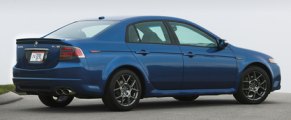 As
always, Acura TL is a premium version of Honda Accord and competes with
German products. Unlike Lexus, the Acura brand is more about driver
appeal,
less about comfort. That’s why when it developed the TL it used the
outgoing
BMW 530i as benchmark (strangely, it actually competes with 330i and
Audi
A4 in the market). The question is: can a bread-and-butter Accord be
developed
into a BMW-fighter? As
always, Acura TL is a premium version of Honda Accord and competes with
German products. Unlike Lexus, the Acura brand is more about driver
appeal,
less about comfort. That’s why when it developed the TL it used the
outgoing
BMW 530i as benchmark (strangely, it actually competes with 330i and
Audi
A4 in the market). The question is: can a bread-and-butter Accord be
developed
into a BMW-fighter?
Externally, the TL looks sharper and sportier than the American Accord on which it is based. They share the same 2740mm wheelbase, but the TL is 8cm shorter, a little wider and a little lower. A much shorter tail and wedge profile deliver a sporty feel. However, detailing is no where as elegant as BMW and Audi. You can still feel its cheaper root. Inside, the cockpit is much better. Materials, build quality and ambience are a match for the German cars. The center console is decorated with real aluminum strips. Being a bigger car, space is of course superior to the 3-series etc. The strongest area is powertrain. the new TL is powered by an improved version of the previous generation’s 3.2-litre 24-valve V6. An increase of compression ratio (from 10.5:1 to 11.0:1) plus smoother intake and exhaust lift horsepower from 260 to 270hp at 6200rpm, while torque is up from 232 to 238lbft at 5000rpm. It is still a sohc 24-valve design, but VTEC variable valve timing and lift and a 2-stage intake manifolds help it to deliver more power at the top end than its rivals. For instance, it exceeds the output of Infiniti G35 by 10 horsepower despite of the smaller displacement, although it isn’t as torquey.
The chassis of TL also underwent enhancement. To save weight at the nose, the Accord’s steel subframe mounting the engine and front suspensions has been replaced by a hydroformed aluminum one. This cuts 11kg. The new subframe is also stronger than before. In addition to the use of more high-strength steel throughout the chassis, torsional rigidity is increased by 24%. The suspensions setting is of course sportier than Accord. This include lower ride height, stiffer springs and dampers, larger anti-roll bars, very aggressive tires (235/45R17) and powerful Brembo brakes.
The problem lies not only in the Accord-rooted layout, but also the tuning technique. Honda might have used BMW 5-series as benchmark car, but the TL never replicates the well-controlled damping of the BMW. On irregular surfaces or occasional speed bumps, the TL floats rather than damps, forcing the driver to slow down. This ruin confidence. Unfortunately,
the market
positioning of TL is rather embarrassing. Because of the addition of
TSX,
it could only occupy a higher and narrower market place (that’s why no
smaller engines are available). Therefore it is forced to compete with
the aforementioned RWD cars. Honda needs to rethink its strategy.
|
| The above report was last updated on 21 Dec 2003. All Rights Reserved. |
 Unquestionably,
The V6 is creamy smooth and eager. It also mates with one of the best
6-speed
manual gearbox in the world, which is renowned for slick and precise
changes.
(Admittedly, most customers will choose the 5-speed automatic instead,
but the manual is definitely the better choice.) This make the
powertrain
incredibly refined. However, it could not topple Infiniti G35 in terms
of real world power and performance. Although Honda claims it take only
6 seconds flat to finish 0-60, the TL doesn’t feel as quick. Blame to
the
older VTEC design, torque curve is not flat. Moreover, weighing 1580kg,
the TL is by no means a lightweight. A manual-transmission G35 is both
lighter and more torquey, thus feels quicker and more powerful on road.
The Acura, however, is smoother and more refined.
Unquestionably,
The V6 is creamy smooth and eager. It also mates with one of the best
6-speed
manual gearbox in the world, which is renowned for slick and precise
changes.
(Admittedly, most customers will choose the 5-speed automatic instead,
but the manual is definitely the better choice.) This make the
powertrain
incredibly refined. However, it could not topple Infiniti G35 in terms
of real world power and performance. Although Honda claims it take only
6 seconds flat to finish 0-60, the TL doesn’t feel as quick. Blame to
the
older VTEC design, torque curve is not flat. Moreover, weighing 1580kg,
the TL is by no means a lightweight. A manual-transmission G35 is both
lighter and more torquey, thus feels quicker and more powerful on road.
The Acura, however, is smoother and more refined.  Nevertheless,
Acura TL is still a FWD car. When it comes to handling, nothing
compares
with a proper RWD chassis. Basically, transmitting 270 horses to the
road
via the front wheels is not a good idea. The TL doesn’t display
noticeable
torque steer in most conditions, but the driving force ruins the
feedback
from the front wheels, especially when you push the car towards its
limit.
Moreover, it doesn’t attack tight bends as eager as the 3-series, A4
and
G35. This read "understeer" in automotive encyclopedia. Blame to the
FWD
as well as the 60:40 front-to-rear weight distribution. No wonder
Infiniti
and Lexus would rather invest into a dedicated RWD platform for their
G35
and GS. No wonder BMW insists RWD.
Nevertheless,
Acura TL is still a FWD car. When it comes to handling, nothing
compares
with a proper RWD chassis. Basically, transmitting 270 horses to the
road
via the front wheels is not a good idea. The TL doesn’t display
noticeable
torque steer in most conditions, but the driving force ruins the
feedback
from the front wheels, especially when you push the car towards its
limit.
Moreover, it doesn’t attack tight bends as eager as the 3-series, A4
and
G35. This read "understeer" in automotive encyclopedia. Blame to the
FWD
as well as the 60:40 front-to-rear weight distribution. No wonder
Infiniti
and Lexus would rather invest into a dedicated RWD platform for their
G35
and GS. No wonder BMW insists RWD.  Few
mainstream car makers put driver appeal on high priority like Honda.
However, mainstream is still mainstream. When compete in premium car
segments, Honda found its Acura TL trails so many miles behind the best
of the class, BMW 3-Series. The reason is very simple: despite of its
premium class pretension, TL is a cheap conversion from your wife's
Honda Accord. Its transverse engine / front-wheel-drive layout
inherently limits its potential in driver appeal. No matter how much
horsepower you give it, it won't corner as quick or as accurate as a
proper RWD sedan.
Few
mainstream car makers put driver appeal on high priority like Honda.
However, mainstream is still mainstream. When compete in premium car
segments, Honda found its Acura TL trails so many miles behind the best
of the class, BMW 3-Series. The reason is very simple: despite of its
premium class pretension, TL is a cheap conversion from your wife's
Honda Accord. Its transverse engine / front-wheel-drive layout
inherently limits its potential in driver appeal. No matter how much
horsepower you give it, it won't corner as quick or as accurate as a
proper RWD sedan.  On the
road, the 3.5 engine feels smooth and powerful, while the 6-speed
manual shifts crisply in the best tradition of Honda. Overall
refinement is good. Nevertheless, from performance point of view the
3.5 V6 is neither the best nor the most efficient. Lexus IS350 produces
20 more horsepower and 20 more lbft of torque from the same capacity,
while BMW 335i's bi-turbo straight-6 produces 20 more horses and 40
lbft more torque yet drinks considerably less fuel. Such differences
can be explained by the fact that (you might not believe) the Honda
engine uses rather outdated technologies: single camshaft per bank,
two-stage VTEC (still no i-VTEC) and the lack of direct fuel injection.
Can't imagine how the engineering-driven Japanese company can be
degraded so much since NSX and the days of its F1 glory.
On the
road, the 3.5 engine feels smooth and powerful, while the 6-speed
manual shifts crisply in the best tradition of Honda. Overall
refinement is good. Nevertheless, from performance point of view the
3.5 V6 is neither the best nor the most efficient. Lexus IS350 produces
20 more horsepower and 20 more lbft of torque from the same capacity,
while BMW 335i's bi-turbo straight-6 produces 20 more horses and 40
lbft more torque yet drinks considerably less fuel. Such differences
can be explained by the fact that (you might not believe) the Honda
engine uses rather outdated technologies: single camshaft per bank,
two-stage VTEC (still no i-VTEC) and the lack of direct fuel injection.
Can't imagine how the engineering-driven Japanese company can be
degraded so much since NSX and the days of its F1 glory.